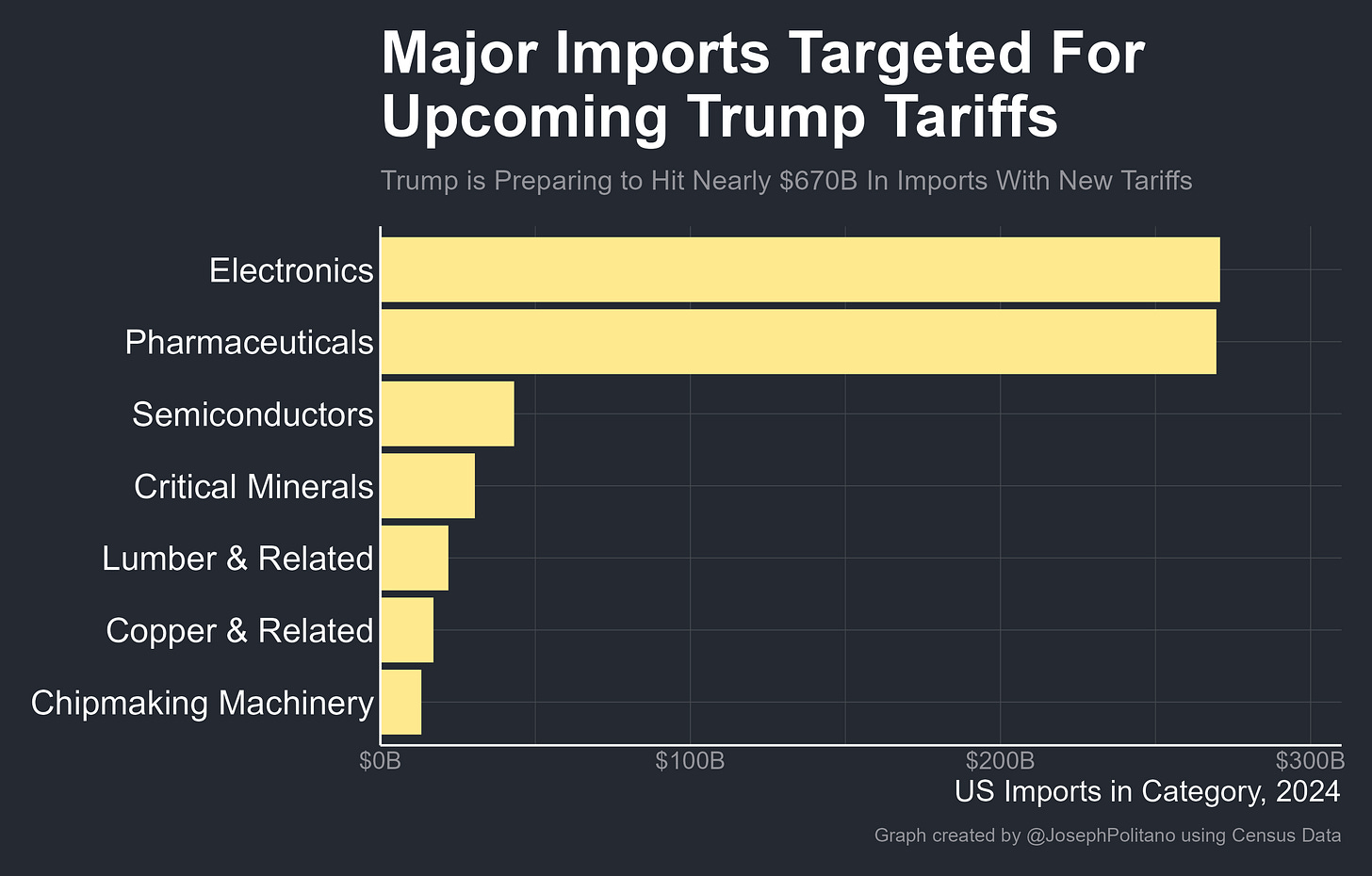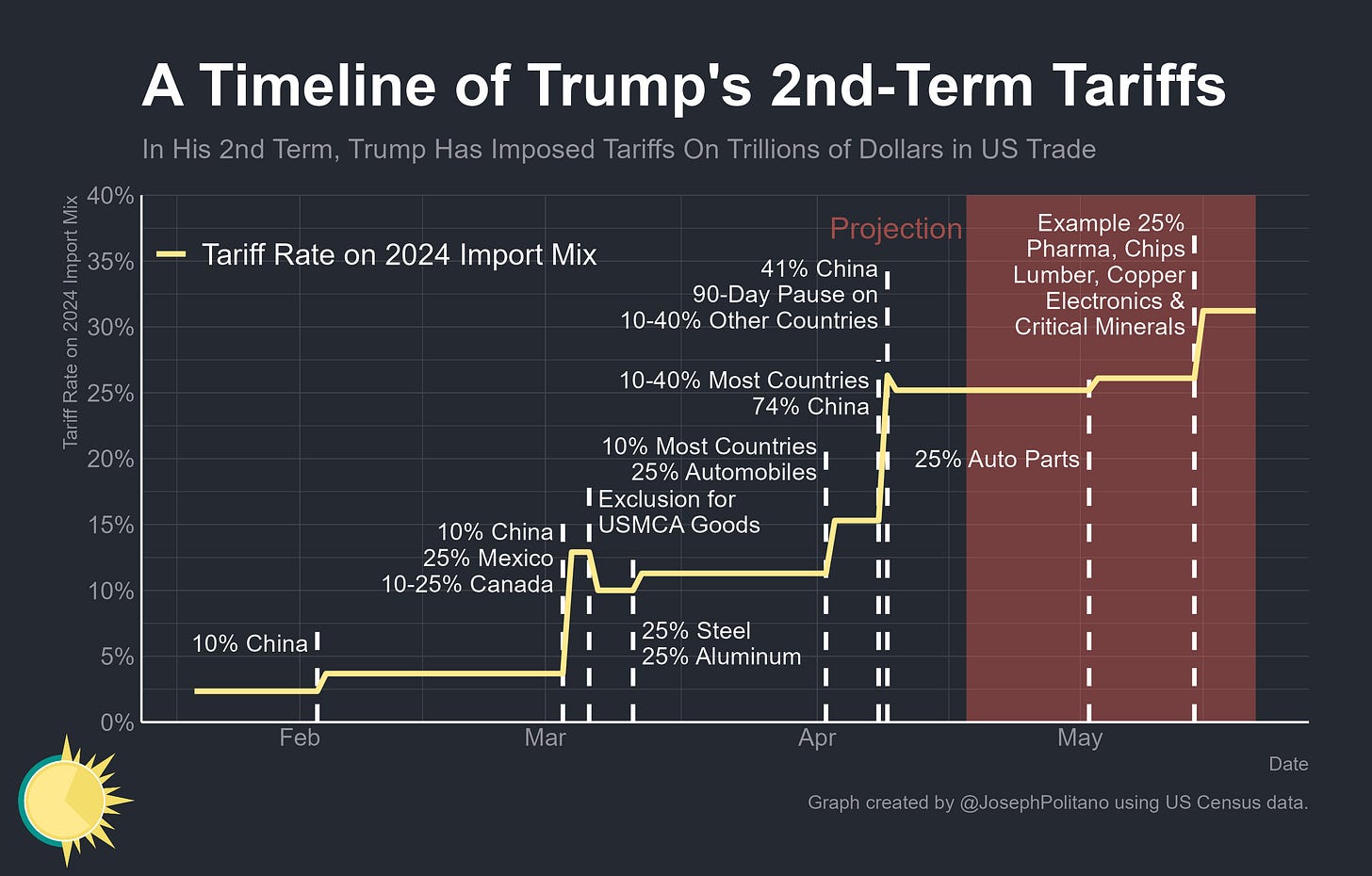The Clues to Trump's Future Tariffs
Trump's Recent Moves Revealed Key Information On His Upcoming Tariffs on Chips, Pharmaceuticals, and More
Thanks for reading! If you haven’t subscribed, please click the button below:
By subscribing you’ll join over 60,000 people who read Apricitas!
When Donald Trump imposed sweeping tariffs on almost all overseas imports earlier this month, he also left detailed clues on his next trade war moves.
The country-level tariffs announced on April 2nd exempted automobiles, car parts, steel, and aluminum because those goods were already hit with 25% universal tariffs, but the White House also published a large 37-page list of other exemptions for everything from sawdust to gold bullion to potassium chloride. The administration categorized those imports as “copper, pharmaceuticals, semiconductors, lumber articles, certain critical minerals, and energy and energy products”—and followed up days later to add specific exemptions for phones, computers, TVs, and chipmaking machinery. Those goods (with the exception of energy) map directly onto the categories of products Trump has mentioned as targets for separate 25% universal tariffs.
In effect, they have revealed the precise list of goods they plan to hit with future tariffs.
These tariffs will likely be authorized under Section 232 of the 1962 Trade Expansion Act, just like the automobile, steel, and aluminum tariffs already in place. This law allows the President to restrict imports of select goods if they impair US national security, yet the President is only granted these powers after the Department of Commerce conducts an investigation and determines that these imports actually do threaten national security. All the Section 232 tariffs imposed by Trump this year have cited investigations done during his first term, so he would need Commerce to complete new investigations before imposing tariffs on, say, critical minerals. That’s why the administration has already kick-started its investigations into the “threats” posed by imports of lumber, copper, pharmaceuticals, and semiconductors.
However, the fact that Trump has openly posted the list of goods to be hit with tariffs is a stunning revelation. In effect, it admits that the Department of Commerce will be conducting sham investigations to arrive at predetermined results that say exactly what the President wants them to say. Presidents have always had lots of influence over the 232 process—after all, they’re usually the ones who call for investigations—but experts at Commerce’s Bureau of Industry and Security are supposed to determine whether imports actually pose a national security threat while recommending exactly which goods should be hit with tariffs and at what levels. Given that the Trump administration has already publicly listed all the goods they want to hit with tariffs and repeatedly centered a tariff rate of 25%, there will be no legitimate investigation. It’s hard to take seriously the claim that imports of children’s picture books, the artificial sweetener sucralose, and dried coral impair US national security, yet all of these goods were exempted from the April 2nd tariffs and thus will likely be deemed threats by Commerce so they can be hit by Section 232 tariffs.
Combined, the targeted products represent roughly $670B in imports in 2024, and if Trump imposed his preferred 25% tariff rate on all of them, it would be equivalent to a roughly 5 percentage point increase in the overall US tariff rate. That is larger, in total impact, than the entirety of Trump’s first-term trade war or the 10% tariffs currently in place against most countries besides China.
Plus, they could go even further—Trump claims he wants to tariff the “whole electronics supply chain” in addition to the previously mentioned semiconductor tariffs, so he could hit a wider range of devices in addition to computers & phones. The April 2nd tariff executive order also exempts “all articles that may become subject to duties pursuant to future actions under Section 232” in addition to the specific copper, semiconductor, pharmaceutical, and lumber exemptions, which implies there are even more universal tariffs under consideration. Trump is far from done with his global trade war.
Breaking Down Trump’s Upcoming Tariffs
Keep reading with a 7-day free trial
Subscribe to Apricitas Economics to keep reading this post and get 7 days of free access to the full post archives.





